Stone brewing in Latvia
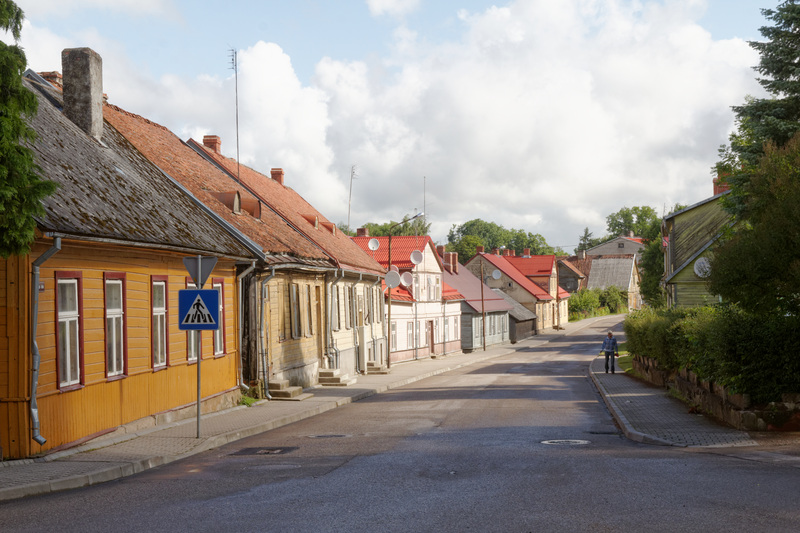
Aizpute backstreet |
The small town of Aizpute, in western Latvia, is home to SERDE, which calls itself an "interdisciplinary art group." Their focus seems to be mostly art, but they also study traditional culture, including traditional brewing. They've travelled around Latvia finding and interviewing traditional brewers, and then brew recreations of these traditional beers now and then in the summer. So I invited myself along to see what I could learn.
Aizpute itself is a small, sleepy provincial town of about 5000 people. It consists mostly of small wooden houses along green, leafy streets, by a small lake in the Tebra river. The local church stands on a hill next to the river. And in the middle of town, right on the main street, is SERDE, in a big, half-timbered 18th century house.
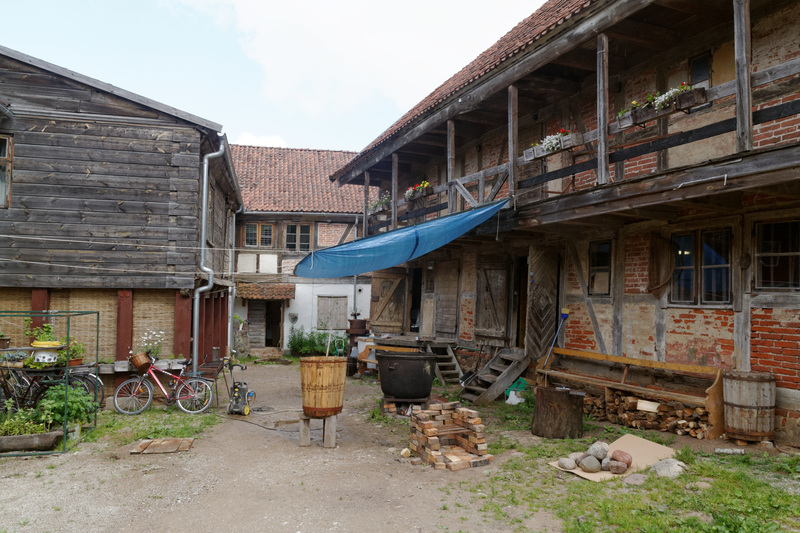
The brewery |
I walked round the corner, into the backyard, and saw a familiar sight: a big iron kettle over a fireplace, and a big wooden vessel on a small stool. Tending the fire was Ugis Pucens, one of the people behind SERDE. His wife, Signe Pucena, is another of the managers of SERDE. She was flitting about in the background, leaving the brewing to her husband. A group of small children were playing in one of the workshops opening onto the backyard, now and then peeking out to stare at the visitor.
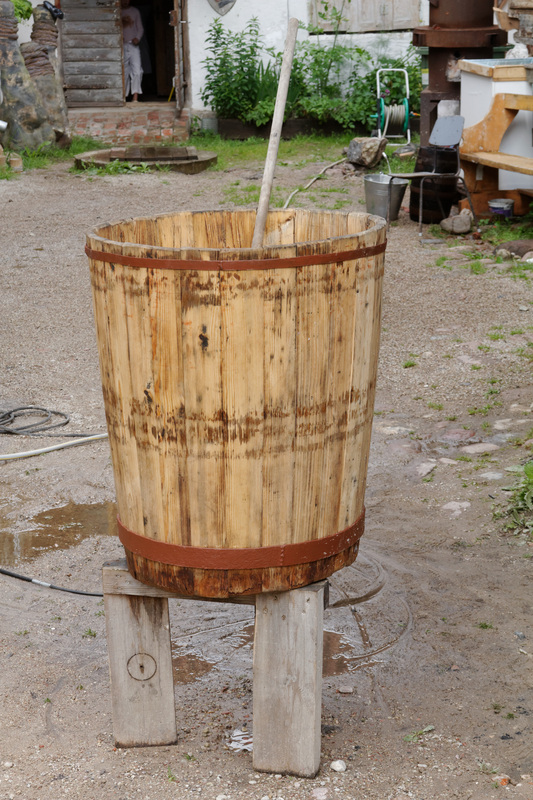
The žeiris |
In the kettle was only water, because this was Latvia, and not Norway. The kettle was being heated for the mashing, which would take place in the strainer (žeiris in Latvian). Interestingly, the strainer was exactly the same type used in Denmark, with a hole in the bottom closed and opened with a wooden rod. In fact, even the three-legged stool underneath was similar. Ugis told me this type was used in western Latvia, while in eastern Latvia people used a low trough of the same design as the Finnish kuurna.
Next to the kettle a Latvian sculptor, who had come along because he wanted to learn how to brew, was grinding the malts. The malts were made by a local malthouse on the edge of town, from 2-row Abava barley. Ugis said this is a strange barley, because it won't make dense wort, so without a reduction boil you can't make beer stronger than 8% with it. The amount of sugar is not the problem: you can keep sparging for a long time. It really is the density that's the issue.
Wooden vessels are difficult to work with, because the wood shrinks and expands, causing leaks to open. People used to solve this by laying them in water for a day or so, so that the wood would swell up and close any leaks. But this wouldn't necessarily close all leaks. In Latvia, people used to solve this with bread putty. Ugis made it simply by wetting bread from the shop and kneading it in his hands to turn it into putty. The putty was then squeezed around the bottom edge of the strainer.
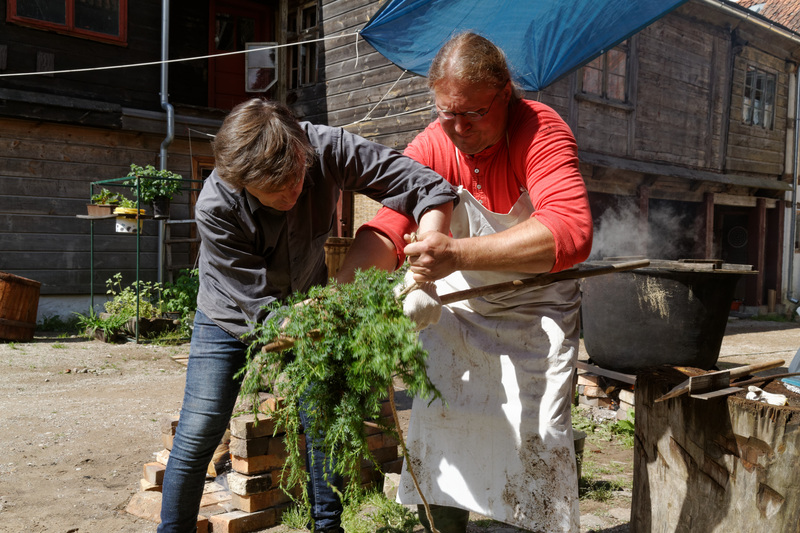
Making the witch's broom |
Ugis mashed in the strainer, through a false bottom with a filter made of juniper branches on top. Norwegians don't mash in the strainer, because if you stir in the strainer itself you disturb the branches on the bottom, so that you can easily lose your filter. The Latvians have a clever solution to this, which is to tie the juniper branches to the wooden rod in an arrangement Ugis calls "the witch's broom."
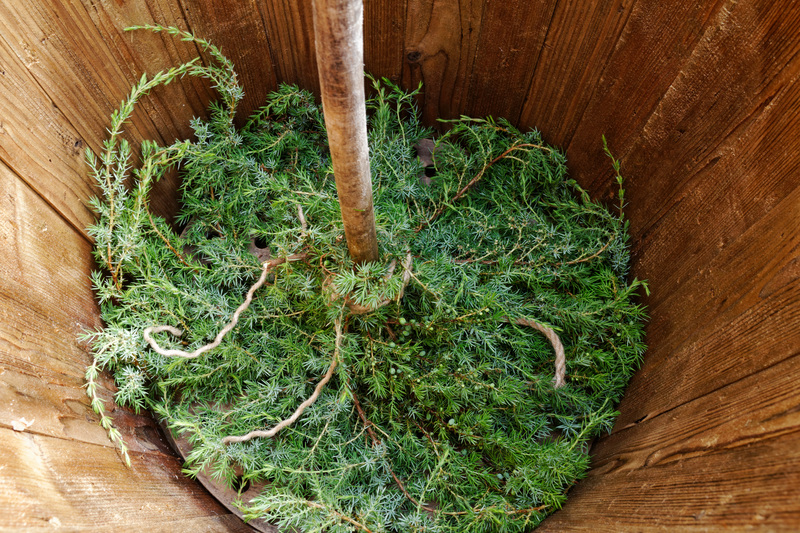
Witch's broom in place (false bottom just visible underneath) |
The ground malts were then added to the strainer, and hot water from the kettle added. Ugis also added some herbs he'd picked in the forest, as well as local wild hops that he'd also picked. Ugis used a second rod to stir the mash, sticking it down to the bottom, then stirring it with a circular motion, systematically moving round the entire vessel. The mash was then left to stand for roughly an hour.

Heating stones |
But we were not done with the mashing yet, because Ugis had been heating stones on a separate fireplace. Once he was ready he took a tin bucket of water and big iron tongs. The first stone was lifted out of the fire and lowered into the bucket, setting off an intense hissing and sending a cloud of steam into the air. This was to clear the stone of ash. Afterwards, the stone was dropped into the strainer, and the hissing and steam began again.
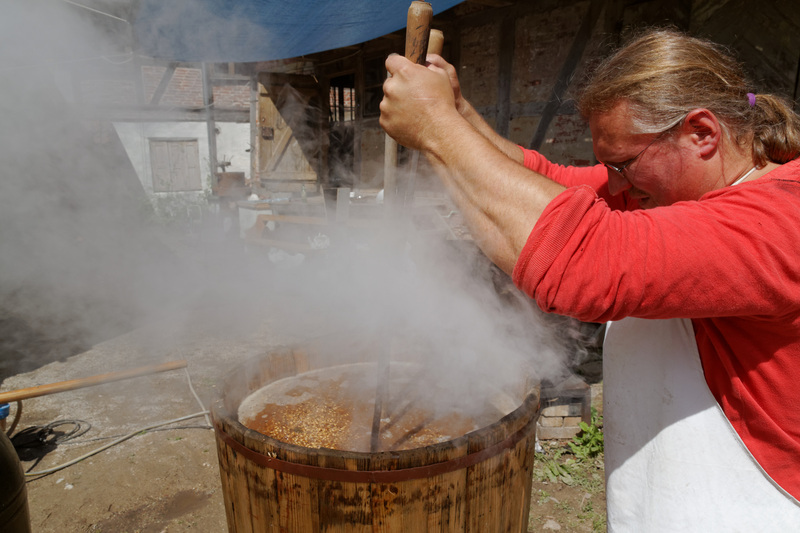
A brewer who actually rocks |
The process was repeated several times with more stones. Some stones cracked when they were lowered into the water, with a sound as loud as a pistol shot. The stones cracked into two pieces, separated by an impressively sharp fault line. The thermal energy of the stones was so enormous I found myself cringing every time a stone approached the water bucket. Dropped into the mash the smaller stones sank without trace, but the bigger ones brought the mash to a boil above them. First bubbles appeared on the surface, then the heat convection brought malt grains to the surface. The boiling lasted a few minutes.
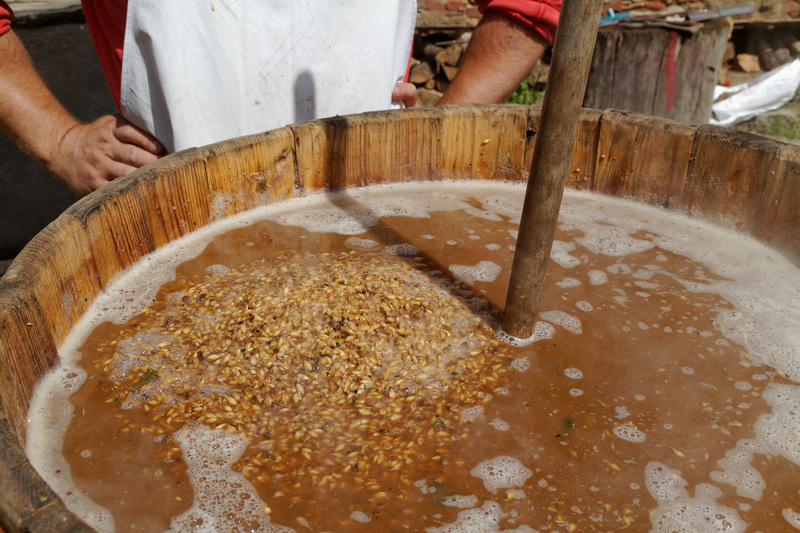
Big stone causing a boil |
I have several accounts of brewing with hot stones in Norway, Finland, and Austria, and what's interesting is that the stones are always used in the mash. People have tended to assume that the stones in stone beers were used to boil the wort, but in fact they seem to always be used to heat the mash. This makes sense, since if you're using stones because you have no kettle, then you won't be able to heat water to pour onto the mash. It follows that you need the stones to be able to mash at all, and very likely these stone brewers never boiled the wort, since boiling for an hour with hot stones is far from easy.
Ugis, however, does boil, and that seems to be not unusual with modern stone beers. Several of the stone brewers seem to have acquired a kettle and used it to boil the wort, but still stuck to the hot stones. Whether they kept using stones because they liked the flavour or out of simple conservatism I don't know.
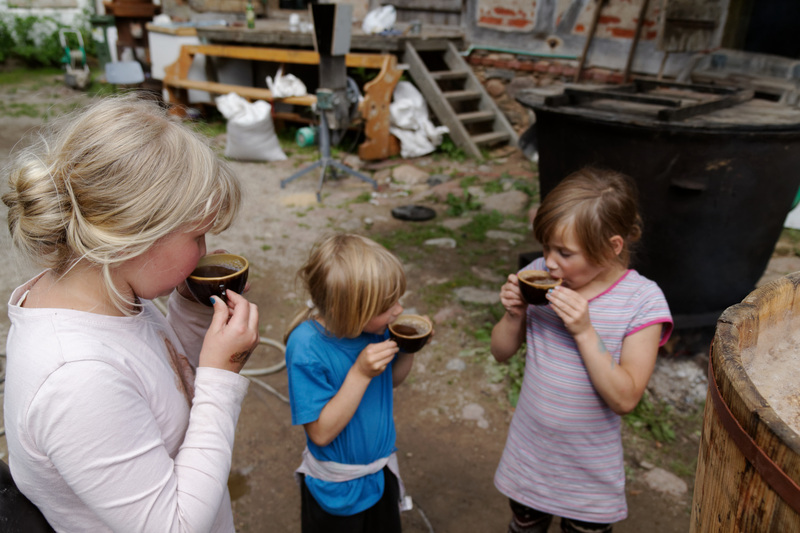
Kids drinking wort |
Once the mashing was over Ugis put a bucket underneath the strainer and lifted the rod. Sweet wort, steaming hot, now ran into the bucket, and suddenly, the children were no longer playing in the workshop, but standing next to the strainer, looking excited. They ran into the house, returning a minute later with cups. They held the cups under the strainer, catching some wort, which they drank with big grins. Clearly drinking the first wort was an old habit of theirs, which is not surprising, given how sweet the wort is. In fact, many older sources say this was common pretty much everywhere. One went on to say that had it been up to the kids, probably the wort would never have been fermented into beer at all.
The buckets that were run off were poured into the barrel until the wort coming out started losing its sweetness. Then the running was almost done. Ugis took some last hot water from the kettle, and poured it onto the strainer. Now he would cover the strainer with plastic, and let it stand until the next day, to make a weak, acidic beer. This is a kind of small beer I've heard of from other sources, too. Usually, people would make small beer by running off weak wort after the main wort and then treat it as they would the main beer, but sometimes they would then go on to do what Ugis did, and leave the wet mash over night.
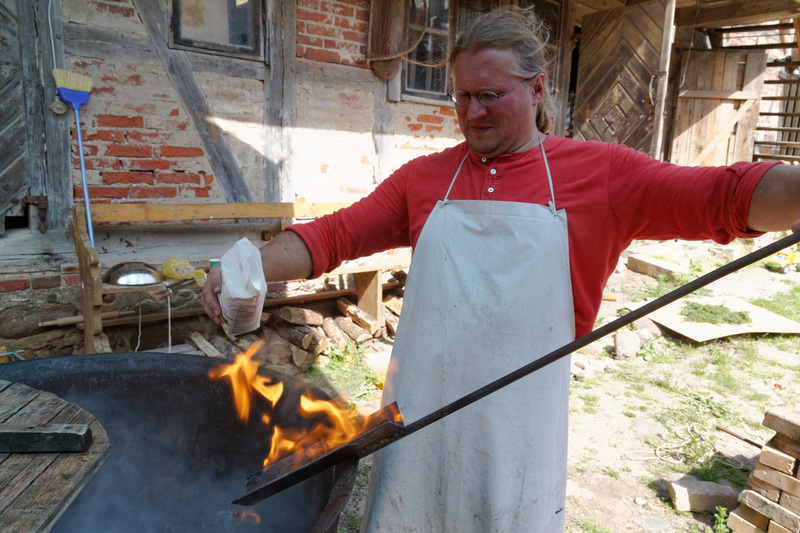
Burning sugar |
The kettle was then emptied of water, and the wort transferred into it for the boil. Hops were added again, but Ugis still wasn't quite finished. In the same fire where he heated the stones he'd had a long steel rod, with an L-shaped wedge at the end. This was now held over the kettle, still red hot, and ordinary white sugar poured onto it. The sugar caught fire, burning with bright yellow flame, before the melted, boiling sugar ran down into the wort. So clearly whoever Ugis got this recipe from was fond of burned sugars, since the stones in the mash were supplemented with actual toasted sugar.
While this was going on, Ugis had prepared the yeast starter. This was done by putting water in a steel bowl, adding a kilo of sugar, and dropping two cubes of Latvian bread yeast in. Ugis says that as far as he knows the traditional yeast is dead in Latvia, so the brewers now use bread yeast. After a while, the water in the bowl was covered in a coarse froth, so obviously the yeast wasted no time in going to work.

Yeast starter |
After the boil, Ugis transferred the the wort by bucket into the fermenter, a plastic barrel in one of the workshops. It was cooled by putting metal milk cans containing cold water into the wort. Once that was done, there was only the cleaning and tidying up left.
Signe and Ugis gave me two leaflets written in Latvian, containing some of the interviews they'd done with local farmhouse brewers. Most of the interviews were from the area around Aizpute, but one was done in Latgale to the east. From what Ugis says there were several different processes used in Latvian brewing, and the one he demonstrated for me was just one of the alternatives. If I can find a translator I should be able to learn a lot more about Latvian brewing.
What the beer tastes like? I never found out, because the next day I drove across the border into Lithuania.

Bottom of the empty kettle |
Similar posts
How stone beer was brewed
It's only the last few centuries that metal kettles have become something that most people could afford to own
Read | 2016-12-18 12:47
Brewing koduõlu on Hiiumaa
On Hiiumaa we drove off the ferry, then a couple hundred meters up the main road, turned off, and within a few minutes we were outside the house
Read | 2018-03-11 15:06
Comments
Alec Latham - 2016-03-13 12:46:14
What a terrific article. I love the images of the children rushing up with cups to collect some of the wort. It reminds me of waiting for my mum to finish making cake batter so I could lick the bowl.
Ivars Avens - 2016-03-13 19:07:32
Would be happy to have a go at translating the leaflets for you.
Marshall - 2016-03-14 08:39:41
My wife is full Latvian, I forwarded this article to her entire family, another fantastic one, Lars! If you want some help translating the leaflets, let me know, I'm sure she'd be happy to help.
Veli-Matti Airaksinen - 2016-03-14 15:40:16
Lars:
excellent blogs. You have done a great service to us lovers of traditional beers. It seems that there is a similar tradition of farmhouse ales from Latvia and Estonia (and possibly Lithuania), Finland, Sweden, Norway and Denmark. Some common (but not obligatory) features: - juniper - no wort boiling Also it seems that step mashing has actually been an old invention. At least here in Finland it has commonly been used for making Sahti, based on traditional techniques without the use of thermometers. Also the use of hot stones for heating the mash is not uncommon.
It is interesting that the Baltic countries, Southern Finland, Sweden, Denmark and Norway pretty much cover the heartland of the Viking age. Only Iceland and northern Britain are missing. This is also the area where "beer" is really "ale", as alus in Latvia, olu in Estonia, olut in Finland, öl in Sweden, Norway and Denmark. One would surmise that a similar tradition existed those parts of England which were settled by the Norse (Yorkshire and Cumbria), but died out a while ago.
Ours might be one of the few surviving original beer cultures. When the Germans were still struggling with getting the lager right, we were brewing, drinking and enjoying! Perhaps we should call this common tradition "North European Farmhouse Ales". Lets find a way to get together each year to compare our ales, and their strengths (weaknesses do not exist).
Lars Marius - 2016-03-14 17:03:26
@Alec, Ivars, Marshall: thank you! Ivars and Marshall, you have mail.
@Veli-Matti: There is definitely a northern European farmhouse ale tradition that's been similar over pretty much the entire area at one point or another. Evidence has started coming in for the UK farmhouse brewing culture, which was also similar. They seem to have used the same type of strainer that Ugis uses.
The reason Iceland has no farmhouse brewing is that grain growing ended there in the Middle Ages, due to a combination of worsening climate and erosion from land overuse. So they didn't have any grain to brew from. It's possible that rich people still bought grain/malts for a while, but I'm pretty sure the brewing culture died centuries ago.
I'm pretty sure the Germans also had a farmhouse brewing culture, in parallel with the commercial brewing culture, but I'm not sure what it was like, or when it died. There was a tradition for "taxing" farmers by forbidding them to brew so that they were forced to buy beer from the landlords instead. However, I'm still lacking information about in what parts of the Germanic area this was the rule.
Also, Russia definitely had a farmhouse brewing culture, and it extended far beyond the ethnic Russian areas, into northern Russia and Siberia.
An all-european farmhouse beer festival sounds like a great idea. :-)
Matias - 2016-03-29 07:05:14
Hi Lars,
I am a homebrewer located in Central Queensland, Australia, and I have found your blog both interesting and informative. I am originally from Finland, so whilst searching for further information on Sahti brewing, I managed to find your blog!
It is really great that someone is looking at the traditional ways of brewing in that region, and how it has been handed down for such a long time and still exists.
Keep up the great work!
Daniel McWhirter - 2016-04-15 13:42:53
Lars, thanks for publishing your experiences. As an American home brewer interested in traditional methods it's been fascinating to follow your travels and get a look into a different brewing culture. Cheers!
Marko Đorđević - 2021-11-04 17:01:50
Zdravo Lars,
always when I read your publications, there is something new, waw. Keep on doing your work, it's fantastic.
There was a word about the old brewing traditions from Latvia, maybe this will help:
- http://dspace.ut.ee/handle/10062/45236?show=full&locale-attribute=de
It's an account from BIELENSTEIN A. 1896, Die nationalen Getränke der alten Letten – [v:]Studien aus dem Gebiete der lettischen Archäologie, Ethnographie und Mythologie, Separatabzug aus dem Magazin der lettisch-litterärischen Gesellschaft, Riga, 35 ss.
And about stone brewing in general, I grew up in the yugoslav side of Koroška, the Slovene name for Carinthia/Kärnten in German. You were mentioning 2 accounts of stone beer brewing, one from Ossiach/Osoje...I'm finishing an archaeological thesis about beer archaeology in general, together with the experiments I have done with what is left over from this beer in today's south Austria. There is not much, besides a couple of account's, if we are speaking about farmhouse production.
There is however quite a lot of literature about the stone beer craftsmen in the cities (Villach/Beljak, Klagenfurt/Celovec)...
If you are interested about this beer (in Slovene the name of koritnjak (korito meaning trough) and in German Stein bier, are mostly names for the beer), write me an email: drekec@gmail.com
All the best from the Slovene Alps,
Marko
Valdis - 2025-01-02 18:47:14
každyj god v Biržai (Lietuva) organizuem prazdnik v usadbe sredi polei i lesov domašnego piva. Okolo 15 čelovek-pivovarov po starinnomu v dereviannoi posude :) neznaju kak po russki. U nas sochranilsia običaji etoi tradiciji, ona živaja. Možet vam interesno bilo .. xotel by poznakomitsia. Žal nemogu prislat video ili foto, nepozvoliaet eta programma
S uvaženiem Valdis